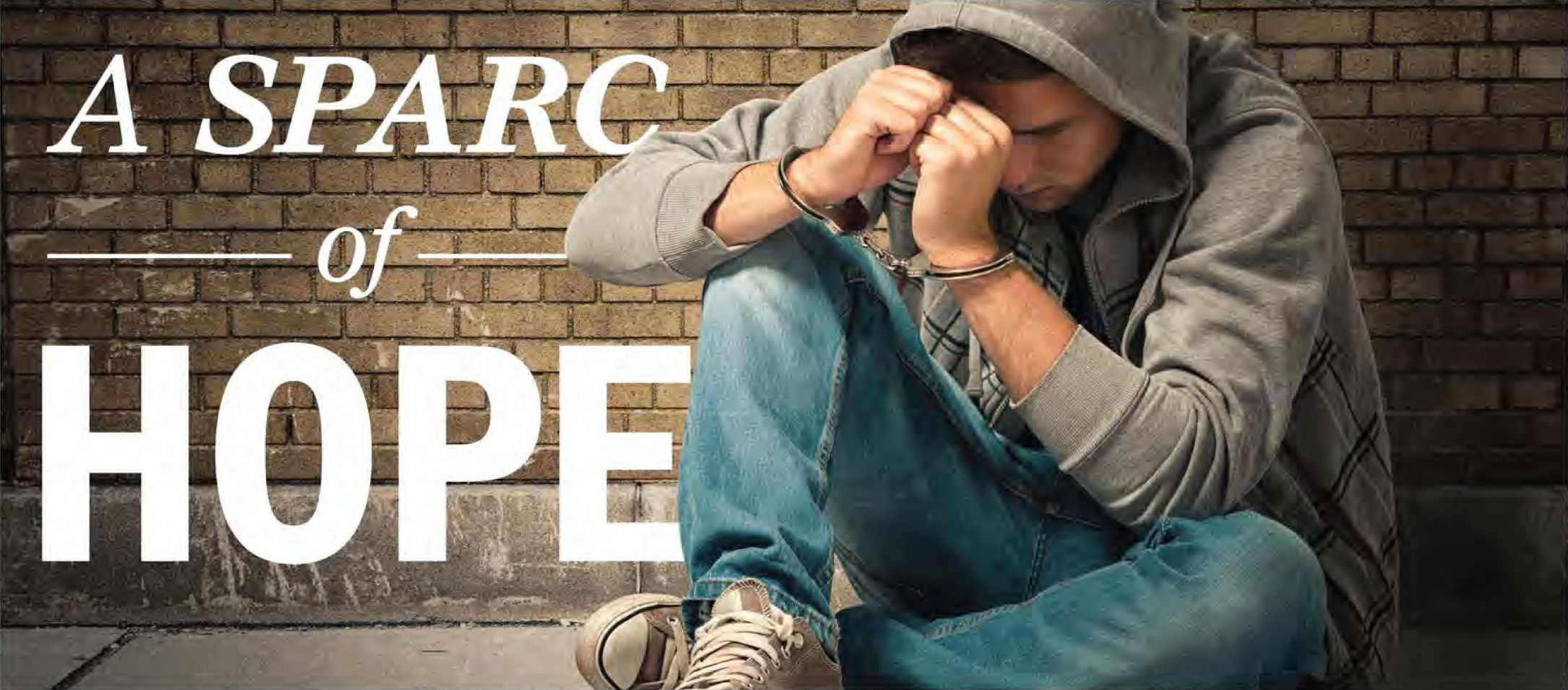
Locals punch tickets to prep football playoffs
November 8, 2017
A SPARC OF HOPE
November 9, 2017Bridging a tenuous gap between unaddressed child misconduct and the harsher aspects of the Terrebonne Parish juvenile justice system is a unique if shape-changing program that can connect children with help and services at the first signs of problems.
SPARC stands for Single Point Assessment and Resource Center. Parents may bring children to its referral experts on their own, before problem conduct gets the attention of authorities. Children also are taken to the SPARC office in the Houma City Court building by police officers and deputies, when they believe a referral might be needed rather than a trip to juvenile detention, or an immediate release to parents. They are also referred by City Court Judge Matt Hagen, who hears Terrebonne’s juvenile cases, as a way for him to better determine what kind of help kids need at various stages in juvenile cases.
The program, child advocates say, is important because Terrebonne places a large number of children in detention, the vast majority of them after arrests for crimes that are minor and petty.
Conflicting and contradicting rules between various agencies that come in contact with children make for some confusion as to when the SPARC is used. What matters, administrators say, is not what process got a child into the SPARC office, but, if the child does go there, what happens when that process begins. If the child comes to the SPARC the parent is expected to come there as well.
“They meet with one of the ladies and discuss what they think is going on,” SPARC director Bernadette Pickett said, referring to what parents should expect.
An assessment is done, using a tool called JIFF — Juvenile Inventory For Functioning — a copyrighted, structured interview that takes about 15 to 30 minutes. The child, the parent or both may be interviewed using the JIFF.
The computer assisted process covers areas such as school and work, home, gamily environment, peer influences, community behavior, potential for self-harm, overall feelings, health needs rational thinking abilities and feelings.
Knowledge gleaned from this process will help a caseworker match up the family with a variety of services. SPARC may be employed at any point.
“OF GREAT VALUE”
A parent can reach out after learning a child has a problem at home or school. A police officer can bring a child to the SPARC, to be met by the parent and begin the process, after issuing a summons. School officials and counselors recommend the SPARC as well, if conduct or even scholastic problems are encountered.
City Court Judge Matt Hagen also refers children to SPARC who are under his probation supervision, or prior to that after arraignment on a criminal charge. A written directive made last year by Hagen requires that children already on probation or with juvenile court cases pending may not be brought to the SPARC. While he himself may send a child there who has a matter before him, the default would in such cases be for an officer to place the child in detention or bring the child with a summons to a parent.
“It has been of great value to us,” Judge Hagen said of the program, which is now part of District Attorney Joe Waitz Jr.’s Juvenile Services Bureau. “A parent can do the assessment while they are there with the child, and get recommendations for services, they don’t have to miss another day of work. When children come to me in court I can also send them for an assessment.”
The resource was originally funded with $250,000 in 2015, approved by the Parish Council and backed by then-parish president Michel Claudet. It will cost $230,000 this year, that’s what the Terrebonne Parish Consolidated Government is being asked for by District Attorney Joe Waitz Jr., under whose budget the SPARC falls. The funding request to the council says the SPARC has three full time workers and one part time employee, a licensed counselor and two caseworkers plus an intake technician.
Although no written documentation has been offered by officials to back up the claim, an understanding exists that money not used by the SPARC will revert to the parish juvenile detention center’s budget, according to Kevin Guidry, administrator for Joe Waitz Jr., and officials at the detention center.
“ANOTHER TOOL”
Kim Vauclin, child welfare and attendance supervisor for the Terrebonne Parish School District, said SPARC staff does presentations for counselors on campuses to familiarize them with what the program does, and how it differs from their own resources.
“It’s another tool in the toolbox,” Vauclin said of the program, noting the extensive access to service potentials school counselors possess.
“It’s gotten great reviews from our people,” said Superintendent of Schools Philip Martin. “We were involved with the planning and had input, and if it can serve as an intervention between having a child incarcerated then it is serving a good purpose. It’s an opportunity for intervention when there is a path needed other than one that would result in incarceration. In any program there are rough spots, but we hear that all the gears are meshing.”
In all cases, SPARC staff follow-up to determine if recommendations are working well, Bernadette Pickett said.
All sides of the juvenile justice paradigm — defenders, prosecutors, jailers, the judge, educators and child welfare advocates — are in agreement that the program plays an important role and will continue to do so.
But there is little uniformity in precisely how it is used. SPARC is an option that may be utilized by agencies coming in primary contact with children like the police.
Police officers have full discretion — even in misdemeanor or status offense cases — as to where they will bring a child if there is contact.
When the police are involved, choices include bringing a child to the SPARC, to the Terrebonne Parish Juvenile Detention Center, or directly to parents. If a child is brought to parents or the SPARC a summons for a future court appearance may or may not be issued.
PLANS AND PROCEDURES
There is no parish ordinance directing that the SPARC be utilized by police. Advocates say the danger in this is that an early potential for determining whether a problem at home is contributing to a child’s poor behavior or criminal act is lost, if the SPARC is not utilized.
Pickett said that if a school resource officer arrests a child, the SPARC should be utilized if the child is not brought to the detention center.
“Anything they do not bring to detention they are supposed to bring to the SPARC,” Pickett said. “That is the deal that we have with the school system when there is an incident at school. That is our plan that is in place. I cannot tell you 100 percent if that procedure is followed.”
Vauclin has a different view. Her understanding is that the supervisors of school resource officers — meaning police supervisors — make the determination, and that the school is not involved in the decision, that there is no “deal.”
The varying understandings between agencies point to a persisting difficulty in Terrebonne’s juvenile justice system overall. City Court keeps detailed and easily produced statistics on its cases, including racial breakdowns of children whose cases are brought before Judge Hagen.
The juvenile detention center has stats on its population, but does not collect data on where the children brought there come from.
School resource officers supply information on arrests and citations to their respective departments, and send copies of those to the school system as well.
But neither City Court nor the SPARC, according to interviews over the past four weeks, have access to such data. The SPARC may have data, but it is not readily available.
NOT BIG ON NUMBERS
When asked for data to back up how the SPARC has operated and demographics on the populations it has helped, Pickett was unable to supply any breakdown beyond the raw number of children seen.
“We aren’t big on the numbers,” Pickett said. “None of my supervisors asked for breakdowns.”
She estimated, however, that about 10 percent of the SPARC’s children are the result walk-ins with parents or appointments made in response to calls initiated by parents.
Pickett said initially said that she has quarterly reports. A check with Guidry, however, revealed that those reports are merely the number of children seen each quarter.
Those numbers do show that SPARC has been utilized more this school year.
In the first quarter of 2017 — January to March — 76 children were seen. The next quarter, ending in June, there were 56 children, and 58 in the third quarter, from July through Sept. 58 children were seen.
Guidry said that from the beginning of the current school term in August through Oct. 20, 107 children were brought into the SPARC.
Without knowing how children were referred or by whom, and whether they were brought by police or if parents initiated contact all on their own, many questions go unanswered.
Data-sharing is already difficult. The detention center is not tapped into the juvenile court’s record keeping system and so cannot determine prior charges and behaviors for classification purposes, as well as what referrals a child has had in the past.
That data can be obtained through phone calls during business hours, however.
Juvenile justice professionals in other parishes interviewed for this story said that tracking and numbers across the spectrum of agencies and entities, from law enforcement to courts to juvenile detention, or agencies similar to the SPARC in Terrebonne, are essential for them. Being able to show metrics and demographics not only aids the process, but also makes it easier for those organizations to seek grants that can help them better service children.
LOCATION, LOCATION
For offenses committed on school property, the data on who goes to detention or gets released to parents appears to vary by agency. While none of the reports provided by the Houma City Police or the Terrebonne Parish Sheriff’s Office contained demographic data, they do show raw numbers of children arrested and brought to the detention center, as opposed to being arrested and then released to parents. Whether any of those children were brought to the SPARC, however, is not reflected in those reports.
At Terrebonne High School during the 2016-2017 school year, five students were booked into the juvenile detention center. One of those cases was for possession of a weapon and drugs. Another was for felony theft and resisting, and also battery on a school teacher. One student was arrested and brought to detention for disturbing the peace by loud and abusive language, as well as resisting arrest.
That same year there were 23 children booked and released to parents according to the police records. Disturbing the peace by fighting was the charge most often pressed, along with a few simple batteries and one possession of tobacco charge.
This school year at Terrebonne High only three arrests resulted in a trip to the detention center. There were 25 children booked and released to parents, again mostly for disturbing the peace by fighting.
At H.L. Bourgeois High School there were 36 arrests in 2016 and 38 summonses issued, with no data to indicate who went where. A total of 15 arrests that year were for disturbing the peace by fighting. This year there were 19 HLB arrests to date, with five purely for disturbing the peace by fighting.
“THE GOAL IS SERVICES”
While data may be sparse, and various data sets bear no relation to each other and thus cannot be processed or compared in a uniform fashion, Bernadette Pickett is confident that the program she now runs has indeed been making a difference.
“We have kept 190 kids out of detention at least,” Pickett said, giving assurances that if parish officials needed to know more specific information, she could have staff separate that data and provide what information is needed.
Pickett acknowledges that there has been friction between people trying to steer Terrebonne’s juvenile system into the future. A diversity of ideals and ideas was certainly evident last month at a meeting of the parish’s Children and Youth Planning Board, a legislatively established entity that Pickett and other key participants in the juvenile system belong to.
The CYPB gave birth to the SPARC, and is where future renovations to the juvenile system will likely come from.
At that meeting Pickett was clear during one discussion about the conflict that can exist for prosecutors who want to help kids but also have overall public safety as a priority.
“Joe (Waitz) feels our job is to help these kids but there is also the public safety aspect,” Pickett said at the meeting, a recording of which was obtained by The Times through ha public records request. “My boss is very concerned about public safety and sitting in my chair I see more than a lot of you all see. We aren’t here to punish kids but the first time a 14-year-old breaks into your house you are going to want them in jail. Everybody deserves a chance but but some have to go to jail as well.”
Pickett said she is aware that there are many different protocols in place.
“We’re still working to see that everybody is on the same page,” she said.













